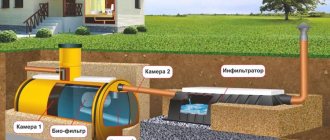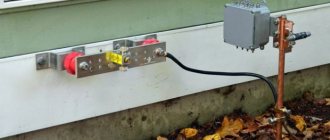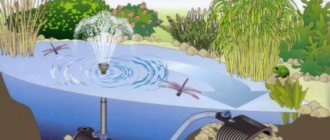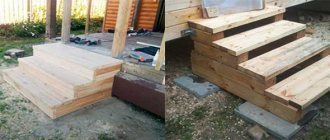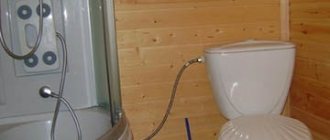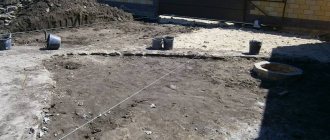Due to the fact that most cottage and dacha settlements are located at a sufficient distance from the central water supply system, the issue of their water supply is especially acute.
In addition, it is not always easy to organize a water supply from nearby wells and wells, since this requires special equipment and communications connected to taps and valves in the house itself.
Septic tank
For such purposes, pumping stations have proven themselves to be excellent, as they have sufficient capacity to properly ensure the supply of water to all necessary points not only at home, but even at the site.
Despite the fact that there is a huge range of plumbing equipment on the market, choosing it is not always easy.
For this reason, you need to know and take into account all the available nuances that will allow you to make the best decision when purchasing water supply equipment.
Purpose of water supply pumping station
A pumping station is necessary primarily in private households with permanent residence, where there is a need for a large amount of water supplied with sufficient pressure.
Pumping stations are used:
- For autonomous water supply to dwellings not connected to main water supply networks;
- For industrial hydraulic extraction in factories or in individual workshops, where not only an artesian aquifer, but also nearby reservoirs or reservoirs can be used as a water source. The main areas of application of such equipment are electric power and metallurgy;
- As components of irrigation networks for fields, greenhouses, orchards and vegetable gardens, water supply to livestock and poultry facilities at agricultural enterprises and country farms.
The main advantages of such devices:
- Automatic control;
- Stable water pressure in the connected water supply network;
- No water hammer in the network;
- Reliability and efficiency thanks to the configuration with a hydraulic accumulator;
- Water supply even in the absence of power supply (in an amount equivalent to the volume of the hydraulic accumulator).
Hydropneumatic tank
Equipping water pumping stations with an accumulation tank will make the system autonomous in the event of a sharp drop in the water level at the source. This is achieved by accumulating the nominal amount of water resource specified in the documents accompanying the product. In addition, it acts as a pressure regulator in the water supply system.
Hydraulic accumulators
The volume of the expansion tank directly depends on resource consumption. Consequently, the greater the number of simultaneously active water points, the larger the required tank volume. The most common station models are equipped with hydropneumatic tanks up to 50 liters. Maximum volume – 100 l.
Advice. If only 1 person lives in a house or country house, then a tank with a volume of 18-21 liters will be sufficient.
Construction of a water supply pumping station
Typical components of the unit are:
- Pump;
- Hydraulic accumulator tank;
- Automation module;
- Pressure gauge;
- Shut-off valves and connection fittings.
The leading unit of the entire system is the circulation pump.
A hydraulic accumulator is necessary to equalize water pressure in the network, dampen water hammer, unload the pump and save energy.
A pressure gauge is a control device that allows you to estimate the pressure in the network. It allows you to fine-tune the pump unit.
The control module is installed to maintain the required pressure in the water supply (usually from 1.5 to 4.5 atmospheres) and prevent the pump from starting without water flow.
- All these components are freely available and, if desired, you can purchase them separately and then independently assemble the unit with the required characteristics.
- However, as a rule, factory-assembled units are cheaper, designed by manufacturers in compliance with all the nuances and tested at the factory.
- Self-assembly of the unit is justified only if you already have any components necessary for assembly, have the knowledge and skills necessary to complete the work, and purchasing the missing parts will cost less than purchasing the unit.
The water intake section of the pipeline must be equipped with a coarse filter to prevent dirt and sand from entering the pump or accumulator, as well as a check valve to prevent reverse flow of water.
How to choose a station?
As when choosing other technical means, it is necessary to take into account a number of factors that can make the acquisition effective and least expensive.
How to obtain permits for construction: list of documents- Modern Bluetooth headphones
Construction services for business
Here are the characteristics worth paying attention to:
- The depth at which the pump operates;
- Station power;
- Station performance;
- Reserve tank volume.
These are the main indicators that you should focus on. In addition to them, there are also secondary characteristics, such as:
- Maximum water rise level;
- Materials from which the pump and battery are made;
- Protection against overheating and idle operation;
- Equipment control method.
There are many products on the market that are equipped with different powers and differ from each other in all of the above parameters, otherwise you should focus on your own needs.
Hydraulic accumulator of the pumping station
A hydraulic accumulator is a metal tank divided inside into two sealed sections by a rubber membrane. When the water part of the tank is filled, the gas on the other side of the membrane is compressed; this pressure will begin to push water out of the accumulator into the network when the shut-off valves are opened.
The hydraulic accumulator serves:
- Maintaining stable pressure in the network;
- Prevention of water hammer;
- Reducing the load on the pump;
- Limited water supply in case of power outage.
The gas pressure on the membrane in the absence of liquid in the accumulator should reach 1.5 atmospheres.
Automatic control unit
The automation of the pumping unit is its main advantage and is intended to control the pump.
- The pressure switch is a key element of the unit.
- Its factory setting provides for starting the pump at a pressure in the tank below 1.4 atmospheres.
- The mark upon reaching which the pump should turn off is set by the manufacturer of the unit based on the technical characteristics of the device.
Some manufacturers equip their units with flow controllers, the purpose of which is to turn off the engine if there is no water supply from the water intake side.
Since the engine is cooled by the pumped water, such a device will prevent it from overheating and breaking down.
Operating principle of the pumping station
The purpose of the pumping unit is to pump water into the hydraulic accumulator until the set pressure is reached, after which the pump is turned off by the control unit.
- The consumption of water leads to a decrease in pressure in the tank and its drop to the lower set limit will lead to the resumption of pump operation until the maximum pressure is reached again.
- Human intervention in this process is required only at the setup stage; all further operation of the pump unit up to scheduled maintenance is fully automated.
The volume of the hydraulic accumulator directly affects the frequency at which the pump is turned on. The larger it is, the less often the pump turns on and, accordingly, the less energy consumption and wear of the pump. The large tank volume also contributes to less membrane wear.
Most often, ready-made units are equipped with membrane hydraulic accumulators with a volume of 14, 20, 50 and 100 liters. The more consumers there are in the network, the larger the volume of the hydraulic accumulator should be. It should also be borne in mind that excessive tank volume will contribute to stagnation of water.
Selecting a model based on specific characteristics
The variety of models on the market is explained by the fact that the conditions for connection can be completely different: some need a pumping station option for a well (with a surface pump installed in a caisson), others need a submersible mechanism or a more powerful model with an ejector capable of pumping water from a well with depth 20-25 m.
When choosing pumping equipment in a store, the properties of the samples provided must be compared with individual requirements.
Calculation of pump performance
There are difficulties with calculating productivity, because many people do not know what to start from. In fact, for objective calculations, several factors should be considered.
For example, it is important to take into account the volume of drawdown of a well - a one-time water intake at zero flow rate, the rate of restoration of the volume of liquid in the source, the mode of active operation of the water supply system, etc.
To find out the average, data for 1 day is enough. This is possible due to the complete restoration of the volume of water in the well in 5-6 hours (the time when the liquid is not consumed at all).
The busiest “rush hours” are periods of time when there is active use of bathrooms or watering of a personal plot. They are the ones most suitable for the objectivity of calculations.
To calculate, you need to add up the parameters of all consumption points, not forgetting the correction factor, and derive the unit of productivity - l/min or l/hour
Let's assume that the well has a flow rate of 200 l, and the drawdown volume is 50 l. If three family members take a bath (200 l each) sequentially, and we need water to flow freely to other water collection points, the productivity should not be lower than 300 l/h.
Sometimes the calculation is made based on the sum of water consumption by all family members or by calculating the maximum water use - peak consumption.
It is assumed that all water points are used simultaneously, the average flow of which is:
- washbasin mixer – 0.1 l/s;
- kitchen mixer – 0.15 m/s;
- drain tank - 0.1 m/s;
- shower – 0.25 l/s;
- washing machine – 0.3 l/s.
The maximum possible productivity is considered to be 800-1000 l/h (or more), but not every well has such a water supply and high recovery rate.
Maximum water intake depth
To find out this parameter, you need to know exactly the dimensions of the well (well) and measure the distance from the installation site of the accumulator to the source.
The basic value is taken to be the height from the water surface to the axis of the pump installed near the well or well. If the station is located at any distance, for example, in the basement of a house, then the horizontal section must also be taken into account.
When making calculations, you should rely on the value of not the static, but the dynamic level - the average value for regular fluid intake for 1-2 days
There is an allowance for error due to the resistance exerted by pipes, check valves and filters. This means that you need to add about 15% more to the amount received.
By the way, the resistance of stainless steel pipes, which is used less and less, is much higher than that of plastic communications.
The vertical arrangement of pipes relates to the horizontal in a ratio of 1:10. For example, the distance to the installation site of the hydraulic accumulator is 20 m, the depth of the well to the water surface is 8 m, therefore, equipment with a minimum intake depth of 8 m + 20 m is needed: 10 = 10 m
Hydraulic accumulator tank volume
When choosing a pumping station for a private home, do not forget to inquire about the volume of the hydraulic accumulator, since the full supply of water depends on the size of the tank. The larger the tank, the more space the equipment takes up and the more expensive the entire installation costs.
It is believed that large tanks have less frequent on/off cycles, which increases their service life significantly.
Gilex Jumbo pumping station with built-in ejector and automatic control: power – 1100 W, hydraulic accumulator capacity – 24 l. Suitable for use in wells and wells
For a single resident or a couple, a volume of 24-30 liters is sufficient. A small container is also appropriate when the need for water supply occurs periodically, for example, on weekends.
A volume of 50 liters is an average capacity, suitable for serving a group or family of 3-5 people permanently living in a country house. For housing that unites more than five people under its roof, you should purchase equipment with a 100-liter tank.
It is irrational to buy containers smaller than 24 liters, as they wear out quickly and, accordingly, have a short service life.
Water pressure in the system
The functioning of the system will be complete and comfortable only if there is sufficient water pressure at each point of water consumption. This means that the pressure in the network ensures an uninterrupted, correct supply.
For example, for a kitchen faucet, a pressure of 1/1.5 atmospheres is sufficient, which equals 10/15 m of water column. More serious equipment requires increased parameters.
Pumping station Grundfos JPBasic2 PT with a power of 600 W and a maximum head of 42 m. Purpose - increasing pressure in household systems, watering summer cottages or gardens
The water pressure value can be found in the instructions. Units with a maximum head of 45-50 m can be used equally well both in country cottages and in small businesses.
They have increased productivity (up to 4500 l/h) and are often equipped with an additional storage tank
Power and voltage
The installation power and supply voltage are necessary for the correct connection of the pumping station. The standard power supply voltage - 220 V - is typical for most household pumping stations, since single-phase AC networks are much more common.
A voltage of 380 V is necessary for high-performance operation of equipment on an industrial scale, and in the residential sector it can only be found in multi-story buildings.
The Parma CH-600P model is equipped with a self-priming pump and is used to supply water to a house or garden from a tank, pool or well. AC voltage – 220 V, power – 600 W
The power of household installations with a hydraulic accumulator is from 600 to 2000 W. It influences the choice of protective devices and power cable. If overheating, short circuit, or dry running occurs, modern models automatically turn off.
Unit type and functionality
Models from the same manufacturer, and even more so from different brands, differ in appearance and potential capabilities.
Suppose a pressure switch, which ensures timely shutdown of equipment, can be connected in two ways: using a flexible hose or directly to the housing. This does not change the principle of operation, only the external design is different.
More serious differences relate to the type of pump - the main working part. The most common are self-priming devices, which easily tolerate light contamination of water and the presence of air in the pipes.
The main disadvantage of units of this type is the limited height of liquid lifting from the source (from 6 to 9 m). Another small drawback is the high noise level, but this can be solved by installing the pump in a separate room.
Some models are equipped with an ejector, built-in or external. The built-in one allows you to increase the depth of water supply to 15 m, while the external one is capable of extracting liquid from a depth of 45-50 m. The disadvantage is reduced efficiency and noise.
The ejector provides recirculating (loop) movement of water thanks to a special design - an additional hose immersed in water with a special nozzle
For wells and boreholes up to 10 m deep, quieter multi-stage devices are used. They are more expensive and more complex in design, have powerful pressure and a high degree of productivity. The main external difference between units of this type is the elongated shape of the working chamber, which accommodates several wheels instead of one.
For summer cottages with a small house and a shallow well (6-7 m), vortex pumping stations are suitable. They are characterized by high pressure (which allows them to be used to increase pressure in the system), quiet operation, efficiency, but low productivity
Reputation of the equipment manufacturer
When choosing this or that model, you definitely pay attention to the manufacturer and try to remember how reliable its products are. This is the right approach, because the life of a pumping station is measured in years, and there is no point in purchasing a low-quality one.
Nowadays, almost all companies involved in the production of pumping equipment are focused on the interests of the consumer and have in their arsenal a whole set of models that differ in technical characteristics.
Well-known domestic brands Gilex, Zubr, Vikhr compete with the Italians Marina, Ergus, Pedrollo in terms of the number of lines presented.
However, the palm belongs to the German brands Gardena, Metabo, Wilo SE, Kärcher, Grundfos, which have always been distinguished by excellent quality and maximum functionality.
All brands that have taken root in Russia have adapted their equipment to local climatic conditions. Let's consider the rating of popular models so that the idea of pumping devices becomes more complete.
Selection of pumping equipment
The operating characteristics of the device are selected based on the upcoming operating conditions.
The main characteristics are:
- Pump motor power;
- Performance;
- Maximum working depth of the pump.
The selection of a pumping station based on productivity is made based on the expected water consumption, taking into account the required height of water rise and pressure in the network. The unit must have a performance reserve of up to 20% of the obtained calculated value.
The volume of the hydraulic accumulator is selected based on the number of water consumers at the rate of 25 liters per person, as well as taking into account the pump performance at the rate of 20 liters of tank volume per 1 m3/h of pump output.
Features of installation work
Self-installation of such equipment is not particularly difficult. And with minimal experience, you can install a pumping station with your own hands.
The main difficulty may be choosing a location to install the station. It should not be located in the open air and at the same time access to equipment for repair and maintenance should be provided.
Installation location and installation
Most often, pumping stations are installed in the basements of residential buildings. But given that such equipment is quite noisy, it may be necessary to soundproof the room or install it outside the house: in a special chamber - a caisson, located near the water intake well, or in a separate outbuilding.
- Since the unit is not large, it does not require concreting or any other foundation. The largest weight of the unit components falls on the hydraulic accumulator, however, it will probably not exceed one hundredweight.
- The pumping station must be provided with free access for maintenance and repair as necessary.
- If the pumping unit will be operated year-round, then the depth of soil freezing for a particular region should be taken into account and the pipes should be laid at the appropriate depth.
The units are supplied by manufacturers in a condition suitable for immediate installation and operation; all that is required is their connection to a water intake well, water supply network and power supply, which must be provided through a residual current device (RCD) to prevent electric shock to consumers.
Equipment connection features
The diagram we are considering and the details of connecting a home pumping station will subsequently eliminate the occurrence of technical inconsistencies in the work.
At the first stage of installation, it is necessary to prepare a supporting base for the pumping unit. It can be made of wood, brick or concrete.
We must cover the surface with a rubber mat in order to reduce the level of vibration of operating equipment.
Using anchor bolts, we fix the legs of the equipment to the base, which will ensure its stability.
The connection process will require the use of an American tap, a one-inch coupling, appropriate diameters of a steel angle with external threads and a check valve. The presence of a check valve will protect the pump from “dry running”.
The valve device includes a spring element and a locking element. Typically, the installation of a check valve is done in front of the station or at the inlet of the suction pipe.
You can also purchase a pipe already equipped with a check valve.
We secure the pipe with a coupling, and fasten the tap using threads.
For the other output of the pumping station, which will communicate with the water supply system, parts are assembled in the following sequence: the tap is connected to the outlet, a propylene combined coupling is mounted into it, and a water pipe is fixed to it by soldering.
Ensure sealing of assembled parts using linen sealing windings and special sealing paste.
After connecting the pumping equipment to the water intake and water supply system, it is recommended to check its correct functioning.
Then you need to open the tap and connect the power supply. The motor will start and water will begin to flow into the pressure pipe, squeezing out all the air.
The pressure will rise to the specified level - 1.5-3 atm, after which the automation will work and the station will turn off.
We recommend watching a video that will clearly demonstrate how to connect a pumping station to the water supply system with your own hands.
Video:
Also, in most private houses (for example, in a country house), a sewage pumping station is installed. It is necessary for pumping out sewer and household waste.
Installing a sewerage station will allow you to equip a kitchen area and a bathroom on the ground floor.
The design of a sewerage station includes the following elements: a tank, a pump, a fill level sensor for a storage tank. Basically, these elements are made of polymer materials, which eliminates the effects of corrosion.
Installation of a sewage pumping station begins with the creation of a project in which it is necessary to carry out all the necessary calculations.
For an internal sewer system, it is necessary to calculate and outline the location of plumbing fixtures and pipes.
For the design of an external sewer system, it is imperative to take into account the condition of the soil and ground. Next, calculate the depth for the pit taking into account the dimensions of the sewage pumping station.
The video below shows the design and operation of a sewage pumping station.
Video:
Possible faults
Modern pumping units are very unpretentious in operation and fail very rarely.
Among the most common problems:
- Too frequent operation of the relay may be a symptom of insufficient pressure in the air chamber, which simply needs to be pumped up to fix the problem;
- The appearance of moisture on the accumulator nipple may indicate damage to its housing or membrane. In this case, it is necessary to replace the membrane or the entire tank;
- Stopping the pump immediately after starting may be a consequence of incorrect adjustment of the pressure switch - the lower limit of the pressure range is too high. The second reason may be airing in the suction hose and subsequent activation of the dry-running protection.
Other malfunctions, as a rule, occur for more significant reasons and require the intervention of a qualified specialist.
How installation is carried out according to various schemes
Connecting the pumping station to the water supply in the house, as mentioned above, can be carried out according to various schemes. In order for you to choose the best one, you should consider each in more detail.
Two-pipe connection
Connecting a pumping station to a well or well using a two-pipe scheme is carried out according to the following algorithm.
- The ejector is pre-assembled (for this you will need a cast iron tee with outlets for connections and a fitting).
- A mechanical cleaning filter is mounted on the lower pipe of the ejector.
- A plastic socket is installed on the upper branch pipe of the ejector, to which a fitting of the required length with a diameter of 1 1/4 inches is connected. To connect a given ejector pipe to a pipeline of a certain diameter, it may be necessary to use several connections.
- To connect the last flow to the pipeline, a coupling made of bronze is used.
- When placing the ejector in a borehole, it must be taken into account that the inlet pipe must be located at a distance of at least 1 meter from the bottom of the underground source, which will protect the device from large stones and sand getting into its interior.
- The length of the plastic pipe to which the ejector is connected before descending into the shaft is calculated as follows: one meter is subtracted from the distance from the bottom of the source to the mouth of the well.
- A pipe bend bent at an angle of 90° is installed at the upper end of the casing pipe. This homemade head is connected to the casing pipe using plumbing tape.
- The upper end of the pipe, which is connected to the ejector, is inserted into the socket of a homemade head and the space between the walls of the pipes is sealed using polyurethane foam. The second socket of such a head is connected to the outer part of the water supply using corner adapters.
- After carrying out the above procedures, it is necessary to connect a well pump with a hydraulic accumulator to the system, configure it to work with an ejector, and perform the first start of the pumping station.
Two-pipe connection diagram for a pump with a remote ejector
You can learn more about what the above-described pumping station piping scheme looks like and how it is practically implemented using a video that is easy to find on the Internet.
When connecting a pumping station to a well with your own hands using a two-pipe scheme, you should avoid the typical mistakes listed below.
- When installing the pipeline leading from the pumping station to the house, the required pipe length margin was not taken into account.
- The threaded connections are not made very reliably and are poorly sealed, which can cause leakage of water supplied to the pipeline.
- No appropriate attention was paid to the hydraulic tank, which should ensure a pressure in the pipeline of at least one and a half atmospheres. If the pressure value is lower, then it should be increased by pumping air into the air chamber using a compressor or a simple pump.

